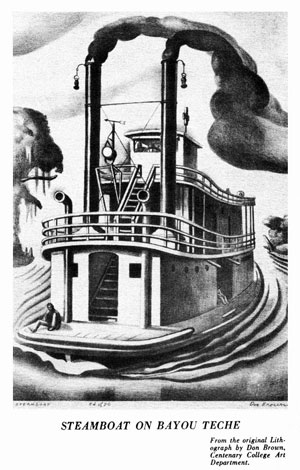
Oak barrels had a tendency to float, even when filled with quality whiskey. Are those barrels at the bottom of the Red River near the mouth Black Bayou or did they float their merry way to Bourbon Street in the French Quarter? Steamboats.com Online Museum
The Red River between Texas and Oklahoma is definitely red. So red it is impossible to see the riverbed when standing knee-deep in water. Now suppose I told you there are 300 barrels of good whiskey somewhere in the bottom of the Red River near the old port of Mrs. Gaffney’s Landing just waiting to be found.
From the 1820s until the early 1870s, steamboats plying the Red River were the easiest, fastest, and maybe the safest way to get to New Orleans. That is if conditions were right. In dry spells there was not enough in the river to float anything but a little dingy, and maybe not then. With too much rain, the overflow caused even worse troubles.
Captain James Broadwell took on 300 oak barrels of good whiskey before stopping at Mrs. Gaffney’s Landing. But when he tied up there on May 1, to take 500 bales of cotton on the LaFitte, she had a draft of three and a half feet. Higher water was needed to float her off down the river.
Broadwell was not only captain of LaFitte, but also an owner who owed $1400 to his partner John Pasley. The steamboat and cargo were duly insured. Broadwell knew the note was due but it had been made out in New Orleans. Therefore, the payment was due in the Crescent City, not at Mrs. Gaffney’s Landing in Texas. If only the water level would rise, everything would work out for him. But Pasley was not agreeable. He demanded that the captain tie up the boat while Pasley went to Clarksville to hire a lawyer and obtain a writ of attachment for the boat.
Early on the morning of May 10th, Broadwell noted a rise in the water, ordered the engineer to get up steam, and just as the crew was ready to lift the gangplank, a deputy sheriff of Red River County jumped aboard with the despicable piece of paper.
Broadwell went ashore, posted a cash bond for $1500. But by the time he returned to the LaFitte, the Red had fallen again. Finally on May 24th water was high enough to set off again. But at the mouth of Black Bayou the steamboat was grounded, stranded, and wrecked taking the 300 barrels of good whiskey down with her. Broadwell’s case dragged on for seven years. Finally in 1866 the Texas court decided that jurisdiction was really in New Orleans, just as Captain Broadwell thought.
Residents, scavengers, and treasure seekers have combed the waters at Mrs. Gaffney’s Landing ever since, even though the channel has changed more than once. To this day, no one has ever recovered the 300 barrels of good whiskey.
Eugene Bowers and Evelyn Oppenheimer collected a wonderful assortment of stories from early Red River County. They were published in Red River Dust in 1968, all humorous and amazing.
